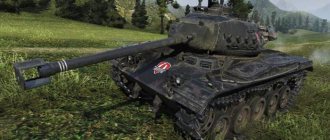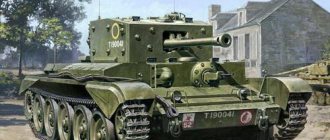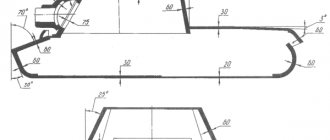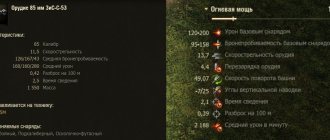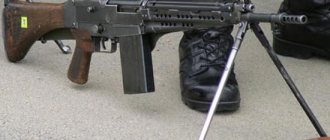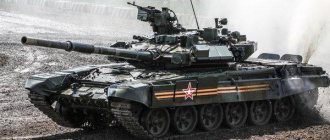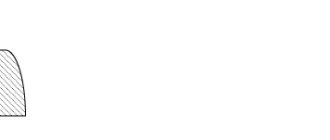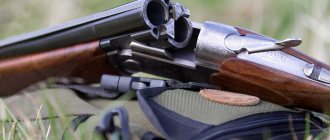One of the most legendary tanks of World War II will receive premium status. The holidays are approaching, and the developers are already preparing incentives for loyal fans of the game.
Greetings, tankers! Here's Wotpack and a short review of the new T-34 gift tank with L-11 . This is in many ways a clone of the pumpable “thirty-four” with the only difference being that it is located at the 4th level.
Most likely it will be a gift for May 9 or for VoT's birthday on August 12. Last year, on Victory Day, the developers organized a full-fledged event with a reward - premium TT IS-2 Shielded. They have set a high bar and of course they will not be able to avoid hate from the players if this time they limit themselves to just a gift tank, and not a particularly original one at that.
Advantages and disadvantages
Against the background of level 4 classmates, we can highlight the key features of the machine.
Advantages:
- rebound hull armor;
- good mobility.
In general, there is not much to say about the strengths of the car. One-time damage and armor penetration are within the average range, but it is difficult to implement due to the tank's flaws listed below.
Flaws:
- poor accuracy;
- long mixing time;
- low damage per minute;
- mediocre viewing radius;
- full level of battles.
Origin of the T-34 tank
“The origin of the T-34 tank - from the Christie tank to the A-32”
In 1935, the BT “fast tanks” could no longer be called a copy of the “Christie tank ,” the prototype of which, purchased from Walter Christie in 1931, served as the basis for the design of the first BT-2 .
Fast tank BT-7. Of course, the “ancestors” of the T-34 can include both the BT-5/2 and the “Christie tank,” but according to this logic, the Assyrian war chariot can also be safely included in the list of ancestors.
Great-grandfather of the T-34, high-speed tank BT-7
The new Soviet tank BT-7 was qualitatively different from everything that came before - it had enhanced armor protection of the hull, welding was actively used in its design, but most importantly, instead of the usual M-5 (Liberty) engine, they installed a more reliable 12-cylinder V-shaped M-17T carburetor engine with a power of 400 hp, fuel reserve increased to 800 liters and a twice increased power reserve.
BT-7M. Still wheeled and tracked, but already diesel.
The vehicle was reliable, fast, but not without one of the main drawbacks of previous models (as, indeed, of all tanks existing at that time in the world) - an aircraft engine, capable of moving a multi-ton hulk, was powered exclusively by high-octane fuel, not only expensive , but also dangerous when it comes to a tank.
It was not possible to solve this problem for a long time, until in 1938 the V-2 diesel engine was installed on the experimental BT-7. The engine turned out to be so successful and suitable for modernization that Soviet tanks were provided with a “heart” for decades to come. The experimental vehicle was given the index A-8 (A is the index of all experimental tanks of the 1930s) and on September 5, 1939, it was recommended to put the tank into production, designating it BT-7M . the Polish 7TP tank already existed by this time , the BT-7 became the first large-scale tank with a diesel engine as a power plant.
BT-IS on wheels. The first attempt to give a rational angle of inclination to armor plates
Almost simultaneously with this, the development and testing of a whole bunch of various improvements for the BT-7 was underway, especially notable here were the BT-IS (BT - Joseph Stalin), the BT-SV - a version of the BT with inclined armor plates, and the "artillery" BT-7A equipped 76.2 mm cannon. However, all these were just tests, developments - the cars did not go into production and were just waiting in the wings. In essence, there was an accumulation of a “critical mass” of innovations, but individually they were all very “raw” and were not suitable for use.
The main reason was not so much the lack of experience among the designers, but the limits of the capabilities of the BT itself - the tank was already overweight, and its transmission needed to be reworked. The solution was found by military engineer 3rd rank Adolf Yakovlevich Dick, who proposed adding one more (fifth) roller to each side of the vehicle, but Mikhail Ilyich Koshkin, who from December 28, 1936 headed the design bureau of tank plant No. 183 and worked on the BT-9 - further modernization of the BT-7, the idea was discarded. Time passed, the BT-9 project was at first simply late, and then completely missed all the design deadlines - the matter took such a serious turn that they started talking about “sabotage” and arrests began...
Tank BT-SV. A real armored turtle from the 30s.
But the fact was that the BT-7, although a good tank, had already exhausted its capabilities. Realizing this, the country's leadership set a new task for the designers - combining experience and using previous developments, to design a completely new combat vehicle, however, also a wheeled-tracked one.
BT-SV in profile
Series A tanks
Mikhail Ilyich Koshkin
The new project received the working name BT-20 . It was assumed that the tank would have a BD-2 diesel engine with a power of 400 hp. with the possibility of boosting up to 600 hp in the future, individual torsion bar suspension and inclined armor plates up to 25 mm thick. The crew consisted of 3 people, and it was planned to arm the vehicle with a 76-mm (as an option - 45-mm) cannon. As you can see, similar in general terms, in details the future B-20 was not at all similar to the BT-7.
Its design was taken away from the “saboteur” Koshkin and Dick was appointed instead, entrusting him with a specially created design bureau. However, Dick and his design bureau, who proposed well from the outside, at first did not meet the deadlines, then they nevertheless provided drawings of the future tank, but with much more modest characteristics. Now his OKB had already been disbanded, and the vacant place was taken by a new group of designers under the code KB-24, the head of which was again appointed Koshkin.
From the very beginning, opinions regarding the concept of the future tank were divided. One part of the specialists defended the idea of creating a purely tracked propulsion system, and the other - a combined wheeled-tracked one.
In order to make a final decision on which type of tank to give preference, in March 1938, a memorandum was sent to the Chairman of the Council of People's Commissars of the USSR V.M. Molotov from the People's Commissar of Defense of the USSR K.E. Voroshilov with a proposal to revise NKO Resolution No. 94 “On Types of Tanks” ...", which, in particular, said:
“A tank designed to operate together with infantry (cavalry) and as part of independent tank formations must be one. For this purpose, it is necessary to develop two types of tanks: one purely tracked and the other wheeled-tracked...” And further, “Create two prototypes of light tanks: one - purely tracked, armed with a 45-mm tank gun and a coaxial machine gun with armor from 12.7-mm bullets from all distances, a maximum speed of 50 - 60 km/h and a weight of no more than 13 t. The second is a wheeled-tracked vehicle with six drive wheels with the same armament and armor, a speed on tracks and wheels of 50 - 60 km/h and a weight of no more than 15 tons. The engine is diesel.”
Experimental tank A-20. From the side, its design still resembles the BT-7 (4 road wheels per side)
In October 1938, Plant No. 183 presented drawings and models of two versions of tanks (wheeled-tracked and tracked) developed according to the proposals of the ABTU commission, which were considered by the Main Military Council on December 9 and 10, 1938.
A-20 - but the front view clearly shows that this is a completely different car
Wheel versus track
By January 15, 1939, working drawings of the hull and turret of the experimental wheeled-tracked tank A-20 and the development of drawings began for a new model of a purely tracked tank with more powerful weapons, which initially had the factory index A-20G (G - tracked), and subsequently it was given a new designation - A-32 .
On February 27, 1939, at a meeting of the Defense Committee, a discussion of drawings and models of the A-20 and A-32 tanks took place. The majority of those present spoke in favor of the A-20, but M.I. Koshkin proposed building both cars at once, to which I.V. Stalin, who was present at the meeting, briefly replied that it was necessary to “give the team the opportunity to work.”
By Decree of the KO under the Council of People's Commissars of the USSR No. 45 of February 27, 1939, the developed drawings and models of the A-20 and A-32 tanks were finally approved for production. The leading engineer of the projects was A.A. Morozov, and the chief designer was M.I. Koshkin.
In less than three months, by May 26, 1939, a prototype of the A-20 tank was assembled (without weapons), tested on a stand and tested on wheels, reaching a speed of 85 km/h.
tank A-32 - this time no wheels, only tracks. Well, five rollers on board
Factory tests of the experimental A-32 tracked tank began in mid-June 1939 and continued until July 16. During testing, the tank repeatedly reached a maximum speed of up to 70 km/h (and on tracks) and covered a total of over 350 km. The results were so good that the vehicle’s armor was increased by another 10 mm, bringing the tank’s weight to 19.6 tons.
Both tanks were undoubtedly a new word in domestic tank building - they were an order of magnitude superior to all previous vehicles. Powerful engines, armor plates with an optimal angle of inclination, reliable transmission, increased security - no other army in the world has had such tanks.
Externally, the A-20 and A-32 were similar, and even in weight they differed only by 1 ton. However, due to the absence of a complex wheeled propulsion system, the armor of the A-32 was almost 2 times thicker than the armor of the A-20, and the 76.2-mm L-10 tank gun was clearly superior in all respects to its fellow “magpie.” At the same time, on track, the A-32 “squeezed out” almost as much as the A-20 on wheels - 74 km/h.
Field tests of both vehicles were carried out in the Kharkov region from July 18 to August 23 by a commission chaired by the head of the 1st department of the ABTU, Major Kulchitsky.
experimental tank A-32. The contours of the legendary "thirty-four" are already clearly visible
During the testing period, the tanks covered: A-20 - 4500 km, and A-32 - 3000 km and in terms of the reliability of the mechanisms they showed completely equivalent results, in all respects “making” the most advanced BT-7 in service at that time. Both tanks were recommended for production, however, as noted, the A-32 tank, due to its higher survivability and firepower, was clearly superior to the A-20 and could well have been further strengthened by increasing the armor capacity to 45 mm.
The common disadvantage of both vehicles was the cramped space and insufficient design of the crew members' work stations - a quality that will be an indispensable companion of domestic tanks for a long time.
Birth of the T-34 tank
On September 19, 1939, the People's Commissariat of Defense raised with the government the question of accepting both tanks for service with the Red Army and manufacturing at plant No. 183 by December 1, 1939 an experimental batch of A-32 tanks with 45 mm armor in the amount of 10 vehicles and an installation batch of A tanks -20 - 10 vehicles by January 1, 1940. Before the start of production of the pilot batch of the A-20 design bureau tank from plant No. 183, all identified defects had to be eliminated and the thickness of the front hull plate had to be further increased to 25 mm and the bottom in the bow to 15 mm.
Is this still an A-34 or already a T-34?
Throughout the next week, the fate of the A-20 and A-32 medium tanks was decided at the government level. The result of these discussions was a draft Resolution of the KO under the Council of People's Commissars of the USSR dated September 25, 1939, which recommended only one vehicle for production - the A-32. But it was accepted for production under a different, long-familiar index: T-34 .
This name was assigned to the tank “in advance” - the car was still very “raw” and did not immediately go into production. It took some more time to refine and debug various components, the result of which was the next experimental tank - the A-34 . Compared to the A-32, it was 5.5 tons heavier, had a speed of “only” (yep, only) 54 km/h, was 30.4 cm longer, 45 cm wider and 6 mm lower.
Tank T-34 model 1940. Or as it is also called T-34-76
On February 10, 1940, Plant No. 183 presented the first two production T-34 (A-34) tanks to the commission chaired by Colonel V.N. Chernyaev for military testing. And on March 5, 1940, both vehicles began their historic run along the Kharkov-Moscow route, and M. Koshkin himself was behind the levers of one of the tanks. The T-34 began its journey into legend.
Interesting fact : by the same decree that adopted the T-34, such honored combat vehicles as the KB-1, BT-7M, T-40 tanks, the Voroshilovets tractor, ST-2 and STZ-5 tractors were also adopted , BA-11 armored vehicle, GAZ-61 and ZIS-5 vehicles.
From right to left, tanks are depicted: T-34, its prototype A-32, “pre-project” A-20 and “great-grandfather” BT-7
source: compilation from materials publicly available on the Internet, quotes from the book “Unknown T-34”
Equipment selection
Considering that this is the 5th level and there are no profile slots yet, but there are enough shortcomings that need to be improved - choose the equipment assembly that is most suitable for your type of game.
| Slot | Equipment | Properties |
| 1 | Turbocharger | Increases engine power, allowing you to accelerate, maneuver and climb hills faster. Increases the maximum speed of the vehicle forward and backward, which will allow you to quickly take a position and avoid return fire. |
| 2 | Rammer | Speeds up gun reloading, thereby increasing damage per minute. |
| 3 | Vertical stabilizer | Reducing the dispersion is an important factor, because the smaller the initial dispersion of the gun, the smaller the circle in diameter the convergence will begin, which means it will go faster. In addition, an unprepared shot (a shot without aiming or on the move) will also be more accurate. |
| Slot | Equipment | Properties |
| 1 | Improved ventilation | Improves many characteristics of the vehicle: visibility, rate of fire, aiming time, dynamic characteristics, and so on. However, the increase itself is very small and will only be noticeable in conjunction with the “Combat Brotherhood” skill, which has been learned from the crew |
| 2 | Rammer | Speeds up gun reloading, thereby increasing damage per minute. |
| 3 | Vertical stabilizer | Reducing the dispersion is an important factor, because the smaller the initial dispersion of the gun, the smaller the circle in diameter the convergence will begin, which means it will go faster. In addition, an unprepared shot (a shot without aiming or on the move) will also be more accurate. |
In this case, you can replace Ventilation with Coated Optics to slightly correct the “blindness” of the tank.
Booking
And in close combat we are partly helped by our unsurpassed tower. 170 mm in the forehead, 150 mm on the sides, 80 mm in the rear, plus the rounded shape allows you to sometimes catch non-penetrations and ricochets even from the TT-9 with top guns. And at the top not a single anti-tank missile will hit us in the forehead.
But the T-34-1 is a Chinese tank (in every respect). Therefore, a cardboard case is stored under the reinforced concrete tower. Armor in the forehead - 60 mm. Even excellent angles of armor plates do not save us from being penetrated by cannons of level 5 tanks. So the Chinese ST-7 can be sewn into the body by anyone, anywhere. The ammunition stowage is stored immediately under the turret on both sides of the hull. One-shots and damage to the ammo happen, although not as often as, for example, with the T-44. But what is not uncommon is a fire. The engine occupies almost the entire aft compartment, and huge fuel tanks hang over it (the body is borrowed from Soviet cars).
Click and read: Light Tank HWK 30


